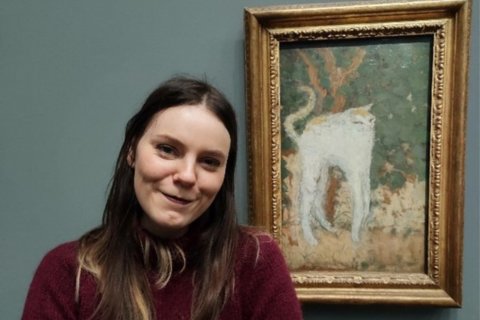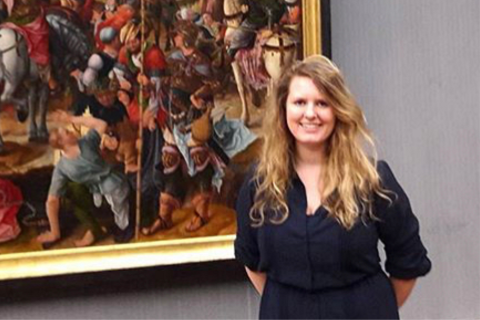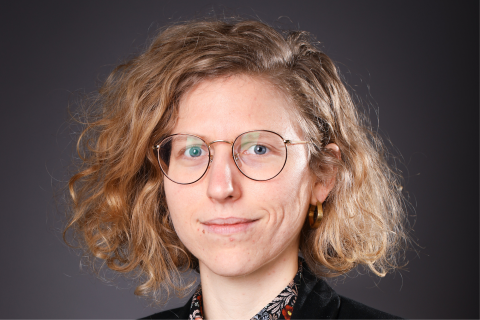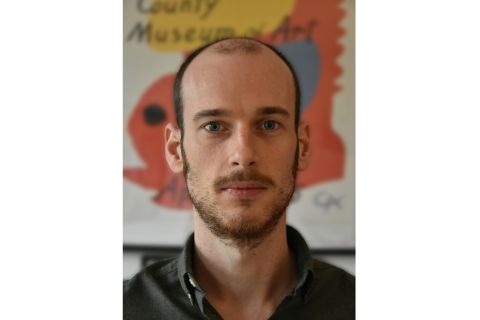Testimonials
Christien Schrover is a PhD candidate at Utrecht University

"I chose this Master's based on my interest in late medieval Dutch art and in technical art history, both subjects that were well represented in the programme. As a result, I landed an internship at the Mayer van den Bergh Museum in Antwerp, a museum with a large collection of medieval art. At this museum, I did research on the archive and on the construction of the collection - a very relevant experience for me in which I also wrote my first academic publication."
Read more
"Meanwhile, I started as a PhD candidate at Utrecht University, looking at late medieval altarpieces and 3D reconstruction technology. What I liked about the Master's was that there was a lot of room to explore my own interests, and to decide for myself what kind of topics I found interesting."
Nelleke de Vries has a PhD position at Ludwig-Maximilians Universität München

"Already during my Bachelor Art History at Utrecht University, I thoroughly enjoyed conducting research into the field of fifteenth- and sixteenth-century Netherlandish art. What attracted me most about this Research Master was the considerable freedom in setting up your own research projects. Because of this, I was able to deepen my knowledge of Netherlandish art and expand my research skills, preparing me for the position I have now."
Read more
"During my Master’s, I obtained experience in an international museum, through an internship at the curatorial department of the Gemäldegalerie der Staatliche Museen in Berlin. I was able to work together with the curator of Early Netherlandish and French Art, as well as the curator of Dutch and Flemish Seventeenth-Century Art. I assisted with exhibitions, conducted research on pieces from the permanent collection and familiarized myself with technical research. These skills and experiences proved invaluable for obtaining a position after the research Master’s programme.
After finishing the programme, I gained experience at the Netherlands Institute for Art History and Stedelijk Museum Alkmaar as a researcher, before obtaining a position as a doctoral researcher at the Ludwig-Maximilians-Universität in Munich. Here, I carry out research for my PhD as part of the ERC-funded project SACRIMA. In addition to writing my dissertation, I co-organize symposiums and workshops and assist with both Bachelor and Master courses. The skills I obtained in Utrecht, such as setting up your own research projects, investigating primary and secondary sources, and conveying your findings in a comprehensive way, are all skills I still profit from daily.
In the future, I hope to further expand my knowledge and skills in the field of Early Netherlandish art, and to eventually become a museum’s curator."
V.E. Mandry has a PhD position at University of Konstanz

“I was always interested in studying Dutch art. My choice for Utrecht was obvious: the RMA was perfect for what I was looking for and the city is really welcoming and pleasant to live in. I chose this programme for several reasons. First, I love working and studying with international colleagues and students. The programme’s focus is on Dutch artistic production and number of courses considered the early modern period in which I am the most interested. Finally, I liked the combination between theoretical research and internship in museums. Academia and museums are often missing contact with one another, which is problematic. In Utrecht I had the opportunity to meet professionals from art institutions and get insight into different facets of current research and projects."
Read more
"During the RMA, I realized that I wanted to go further in research. Instead of focusing on traditional art historical methods, the programme made students aware of interdisciplinary approaches in art history such as technical art history, or research overlapping with other disciplines such as history of sciences, etc. I therefore acquired a large knowledge about different aspects of the early modern Dutch culture in a global context. Furthermore, I felt well-prepared to apply for PhD positions and to present my research in conferences.
The RMA Thesis was an amazing process and I felt well guided by my supervisor. I could develop excellent skills as a researcher as well as on the personal level (learning Dutch and academic English, being integrated in the Dutch culture, going to a large choice of cultural events, etc).
I did my internship at the museum Mayer van den Bergh in Antwerp. It is a small museum, which is an advantage because I was completely free to do what I wanted. I took this opportunity to research on their collection of still lives and to develop a concept for an exhibition about insects in still-life paintings. It was a great experience to examine so closely paintings while studying them. I could learn different facets of the museum world such as organizing small exhibitions, following the process of loans, researching in archives, meeting restorers, etc. I would recommend it to anyone who is interested into new adventures.
Right after my Master, I got a position in Germany and integrated an interdisciplinary Graduate Research Programme at the University of Konstanz in collaboration with the Stuttgart Academy. I am currently benefitting from the international network that I acquired during my time in Utrecht, as well as the research skills I could develop there.”
Ruben Suykerbuyk is the Curator of Old Masters at Museum Boijmans Van Beuningen

“Every day I do what I really love: conducting research on a topic that interests me endlessly, 16th century Netherlandish art. Before I came to Utrecht, I had already finished a Master in Art History at the University of Ghent. However, I did not yet feel mature enough to start a PhD project. I signed up for the two-year Art History programme in Utrecht, to be better prepared for doctoral research."
Read more
"What attracted me most to this Master was the considerable freedom, for instance in the tutorials. Every student is able to conduct an independent small research project, under supervision of the preferred tutor. The whole programme is designed not so much as a one-way education (i.e. the professor who teaches and the students who reproduce), but rather as a very dynamic system, wherein the students participate actively themselves.
During my internship in Vienna, my previous thesis supervisor from Ghent contacted me and asked me if I wanted to work on a project that he would co-supervise. As a post-doc researcher I was constantly encouraged to communicate about my research, either via articles or presentations. For example, I organised an international expert workshop with the project members. Apart from conducting my own research, being a PhD student also meant helping out with some educational jobs, like supervising Bachelor seminars.
My ambitions? I used to say if one day I were a curator in a museum, I would be a very happy man. It would be great to be able to directly work with the artworks themselves. Now this dream has come true: since April 2021 I am the Curator of Old Masters at Museum Boijmans Van Beuningen. I will be engaged in research and care of the collection of old masters, with works from Van Eyck, Bosch, Bruegel and Titian, to Rembrandt and more.”

